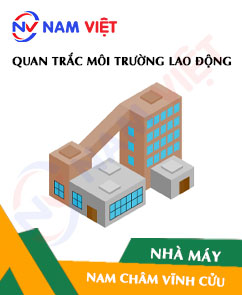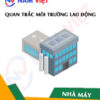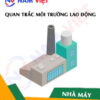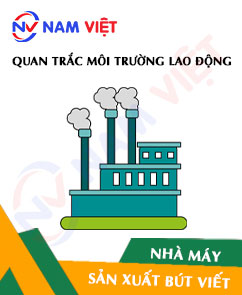Occupational environment monitoring at the factory producing permanent magnets
99,000 ₫
Note: The above price is calculated for one sample. Prices may fluctuate depending on the area of the environment to be monitored and market conditions. For more accurate pricing support, please refer to the price list or contact our consulting staff directly.
Workplace environment monitoring for a permanent magnet production factory is a session of collecting, analyzing, and evaluating factors at the workplace that may be harmful to workers health.
Table of Contents
Toggle1. Overview of Permanent Magnet Manufacturing Factories
a. What is a permanent magnet manufacturing factory?
A manufacturing factory for permanent magnets is a facility specialized in producing and processing various types of permanent magnets. Permanent magnets are magnets that retain their magnetic properties independently after being created, without losing their magnetic strength over time. They are widely used in numerous fields, including industry, electronics, healthcare, automotive, electrical appliances, and many other applications.
The machinery and equipment used in permanent magnet manufacturing factories include melting furnaces, processing machines (grinders, cutters), shaping machines, magnetizing machines, and quality inspection equipment.
Permanent magnet manufacturing factories ensure product quality and consistency and supply permanent magnet products for various industries and applications.

b. Production stages in permanent magnet manufacturing factories
Production stages in permanent magnet manufacturing factories generally include the following:
- Material preparation: Collecting and preparing magnetic materials such as iron, cobalt, nickel, and other additives. These materials are measured and quality-checked before use.
- Alloying process: The magnetic materials are blended and alloyed according to the proper ratio. This process may involve melting the materials and mixtures to form a magnet alloy.
- Shaping: The magnet alloy is shaped into specific forms through processing technologies such as casting, pressing, or cutting.
- Heat treatment: Magnets undergo heat treatment, including heating and cooling stages, to enhance magnetic properties and structure.
- Protective coating: Surface protective layers may be applied to magnets to prevent corrosion and oxidation, and to improve durability and mechanical strength.
- Quality inspection: Magnets are inspected to ensure they meet quality standards and specific requirements. Inspections may include measuring magnetic properties, mechanical strength testing, and verifying dimensions and shapes.
- Packing and transportation: After completion, magnets are packaged and prepared for shipment to customers or distributors.

c. Machinery used in permanent magnet manufacturing factories
In permanent magnet manufacturing factories, several essential machines and equipment are used to carry out production stages. Common types include:
- Melting furnace: Used to melt and alloy magnetic materials such as iron, cobalt, nickel, and other additives to form the magnet alloy.
- Coating machine: Used to apply surface protective layers to magnets. Coating methods may include spraying, electroplating, metal plating, or other surface coating technologies.
- Processing machines: Including main processing machines such as lathes, milling machines, grinders, and cutters, used to shape and process permanent magnets to the desired size and shape.
- Heat treatment machine: Used to perform the heat treatment of magnets, including heating and cooling, to improve magnetic properties and structure.
- Quality inspection machines: Includes measurement and quality inspection devices to ensure magnets meet standards and specific requirements. These machines may include magnetometers, dimension measurement devices, mechanical strength testers, and other inspection equipment.
- Packing machines: Used to package completed permanent magnets before market distribution. These may include packaging machines, labeling machines, and other equipment to ensure safe storage and transport.

d. Occupational diseases for workers in permanent magnet manufacturing factories
Workers in permanent magnet manufacturing factories may be exposed to environmental factors that can cause occupational diseases. Common occupational diseases include:
- Respiratory diseases: Exposure to metal dust and metal compounds can cause respiratory problems such as pneumonia, asthma, and sinusitis.
- Skin diseases: Contact with chemicals, solvents, and other agents during magnet production can cause skin irritation, dermatitis, and eczema.
- Cardiovascular diseases: Certain heavy metals, such as nickel, may lead to cardiovascular problems and blood pressure issues.
- Digestive diseases: Exposure to toxic chemicals during magnet production may lead to digestive issues such as enteritis, hepatitis, and liver damage.
- Contact injuries: Exposure to sharp materials and machine components can cause injuries, cuts, scratches, or burns.
To ensure worker safety, health protection and occupational safety measures should be implemented, including using personal protective equipment (helmets, masks, gloves, chemical-resistant clothing), following safe working procedures, minimizing exposure to hazardous substances, providing safety training and education, and conducting periodic health check-ups for workers.

e. Common types of permanent magnets on the market
Common types of permanent magnets include:
- Ferrite magnets: The most common and cost-effective type, made from ferrite—a combination of iron oxide with aluminum, nickel, or zinc oxide. Ferrite magnets are stable and fairly strong, often used in industrial and electronic applications.
- Aluminum-Nickel-Cobalt (Alnico) magnets: Made from an alloy of aluminum, nickel, and cobalt. Alnico magnets have strong magnetic properties and relatively stable temperature performance. They are used in electronics, measurement instruments, and magnetic tools.
- Neodymium (NdFeB) magnets: The strongest and most widely used magnets on the market. Made from a neodymium, iron, and boron alloy, NdFeB magnets have strong magnetic properties, compact size, and good magnetic retention. They are widely applied in industry, electronics, healthcare, and renewable energy sectors.
- Samarium-Cobalt (SmCo) magnets: Strong and temperature-stable magnets made from a samarium-cobalt alloy. SmCo magnets offer high magnetic strength, corrosion resistance, and are used in high-temperature stability applications such as aerospace and medical devices.
2. Overview of Occupational Environment Monitoring Services
a. What is occupational environment monitoring in permanent magnet manufacturing factories?
Occupational environment monitoring (or workplace environmental measurement) in permanent magnet manufacturing factories involves collecting, evaluating, and analyzing measurement indicators of workplace environmental factors to implement timely solutions, minimize environmental hazards to worker health, and prevent occupational diseases. Workplace environment monitoring is a mandatory requirement for permanent magnet manufacturing factories.
Monitoring plays a vital role in caring for, protecting, and enhancing worker health because the workforce is the main resource of the company and directly generates profit. Workers regularly exposed to hazardous factors beyond permissible limits may experience health impacts and occupational diseases.
REGISTER FOR OCCUPATIONAL ENVIRONMENT MONITORING SERVICE
b. Nam Viet’s occupational environment monitoring program
Nam Viet’s occupational environment monitoring program is developed by engineers specializing in occupational safety and environmental protection. With the goal of ensuring worker health and safety, the program employs modern measurement methods to monitor air, water, microclimate, physical factors, dust, and other workplace conditions. This program is essential for maintaining a safe work environment and protecting worker health.
Additionally, Nam Viet’s monitoring program contributes to researching and developing new solutions to improve workplace environmental quality. With the dedication and professionalism of our monitoring experts, Nam Viet’s exclusive program represents a breakthrough in occupational safety and environmental management in Vietnam.

c. Standardization in workplace environmental measurement procedures
Standardization in Nam Viet’s workplace environmental measurement procedures is crucial for ensuring measurement quality. To guarantee accuracy and reliability, the program follows standards and recognized procedures of the Ho Chi Minh City Department of Health. This ensures that collected data is reliable for evaluating the workplace environment and making decisions to improve it and protect worker health.
These standardized procedures also ensure that measurements are conducted by qualified monitoring specialists with years of experience, enabling managers and experts to trust the results provided by An Toàn Nam Viet and make accurate, valuable decisions for occupational health and environmental protection.
By applying standardized procedures, Nam Viet demonstrates its commitment to ensuring a safe workplace, protecting worker health, and contributing to the development and enhancement of occupational safety and environmental management in Vietnam.
d. Monitoring report of permanent magnet manufacturing factories
Workplace environment monitoring results are compiled according to Form No. 04, Appendix III issued with Decree 44/2016/ND-CP and prepared in two copies: one copy is sent to the contracted enterprise, and one copy is kept by the monitoring organization.
The retention period of monitoring results follows legal regulations, with records stored indefinitely.

e. Frequency of workplace environmental monitoring as regulated by law
According to Clause 2 of Article 18 of the Law on Occupational Safety and Health 84/2015/QH13, employers must organize workplace environmental monitoring to assess harmful factors at least once a year.
f. Deadline for submitting workplace environmental monitoring reports as regulated by law
The deadline for submission is before December 31 each year. Enterprises operating production facilities are required to submit workplace environmental monitoring reports to the Department of Health at the locality where the facility is headquartered and where employees are working.
If there are changes in technology, production processes, or when upgrading facilities that may introduce new hazardous factors to worker health, enterprises must update occupational hygiene records regarding harmful factors requiring environmental monitoring.
g. Penalties for violations of workplace environmental monitoring regulations for employers
According to Article 27 of Decree No. 12/2022/ND-CP dated January 17, 2022, regulating administrative sanctions in labor, social insurance, and Vietnamese workers going abroad under contract:
- Clause 2: Fines of VND 2,000,000 – 5,000,000 for employers who fail to publicly announce monitoring results and hazard assessments to workers at the workplace immediately after obtaining the results.
- Clause 3: Fines of VND 20,000,000 – 40,000,000 for employers who do not conduct workplace environmental monitoring to control harmful impacts on worker health as required by law.
- Clause 4: Fines of VND 40,000,000 – 60,000,000 for employers who collaborate with monitoring organizations to commit fraud in environmental monitoring activities, but not to the extent of criminal prosecution.
3. Harmful environmental factors for workers in permanent magnet manufacturing factories
In permanent magnet manufacturing factories, there are several environmental factors that may be harmful to workers. These factors include:
- Dust and magnetic particles: Permanent magnet production can generate dust and metal or additive particles. Exposure and inhalation of these particles can affect the respiratory system and cause health issues such as pneumonia, rhinitis, sinusitis, and allergic reactions.
- Chemicals: The production process may involve chemicals such as solvents, polishing agents, cleaning agents, and adhesives. Exposure and inhalation of these chemicals can irritate the skin and eyes and may harm the nervous system and other internal organs.
- Noise: Production processes can generate noise from machinery and processing equipment. Prolonged and high-level noise can lead to hearing problems, stress, and worker fatigue.
- Temperature and working conditions: Working conditions in permanent magnet factories may be uncomfortable, especially near heating areas or high-temperature machinery. This can cause health issues such as heat stress, fatigue, and thermal imbalance.
- Production safety: The production process may involve heavy equipment, material handling, and complex processing procedures. This creates risks of accidents and injuries if safety measures are not properly followed.
REGISTER FOR OCCUPATIONAL ENVIRONMENT MONITORING SERVICE
4. Measures to improve working conditions in permanent magnet manufacturing factories
To improve working conditions and protect worker health in permanent magnet factories, the following measures can be applied:
- Dust and particle management: Use effective dust extraction systems and personal protective equipment such as masks, gloves, and protective clothing to prevent contact with dust and particles. Ensure regular industrial hygiene and workplace cleaning.
- Chemical management: Implement safety measures when handling chemicals, including wearing protective gear, using ventilation systems, and following safety regulations and guidelines. Ensure proper storage, handling, and disposal of chemicals.
- Noise control: Use protective equipment such as earplugs or earmuffs to reduce noise at the source and comply with occupational noise safety standards. Install sound barriers or soundproof work areas to minimize noise spread.
- Adjust temperature and working conditions: Provide appropriate cooling or heating measures to ensure comfortable working conditions. Ensure ventilation and fans operate effectively to improve air circulation.
- Training and safety awareness: Train employees on potential hazards, safety procedures, proper use of protective equipment, and accident prevention measures. Create a safe work environment and encourage employees to report safety and health issues.
- Equipment inspection and maintenance: Ensure machinery and equipment are regularly inspected, maintained, and properly operated to prevent accidents and unexpected failures.
- Monitoring and compliance: Comply with regulations, standards, and guidelines on safety, hygiene, and environment related to permanent magnet production.
- Periodically conduct occupational environment monitoring in factories to collect and analyze harmful factors, and adjust measures to reduce risks and prevent occupational diseases.
5. Benefits of periodic monitoring in permanent magnet manufacturing factories
An Toan Nam Viet provides businesses with great benefits when using occupational environment monitoring services in accordance with Decree 44/2016/ND-CP on managing and controlling harmful workplace factors affecting workers.
- Businesses can proactively control harmful factors in workshops or factories.
- Receive advice and recommendations on measures to reduce harmful factors and improve workplace quality.
- Indirectly protect human resources, a key factor in business development.
- Reduce the harmful effects of occupational diseases on worker health, minimizing future medical costs.
- Improved worker health leads to better product quality and consistent production output.
- Ensure compliance with labor safety laws, avoiding legal risks.
- Enhance credibility and professionalism, elevating the company’s brand.
Nam Viet’s environmental monitoring service is a solution to reduce occupational disease risks, contributing to a clean and high-quality working environment.

6. National occupational environment monitoring center
Occupational environment monitoring center of Nam Viet is a professional unit specializing in monitoring and measuring workplace environmental quality across all provinces in Vietnam. With a team of experienced monitoring specialists, the center uses modern measurement equipment to ensure accuracy and reliability.
In addition to monitoring services, the center supports clients in planning, managing, and tracking occupational environmental issues. With the motto “customer-centered,” the center prioritizes client satisfaction, meets all client needs, and provides the best solutions for businesses.
REGISTER FOR OCCUPATIONAL ENVIRONMENT MONITORING SERVICE
With investments in technology, equipment, and human resources, Nam Viet’s monitoring center has become one of the most reputable units in occupational environment monitoring in Ho Chi Minh City, with the following objectives:
- We always value our brand reputation and the quality of our services.
- We provide clients with the best and most suitable solutions possible.
- With a team of experienced Masters and Engineers, committed to environmental protection and business benefits.
- By choosing Nam Viet Environmental Monitoring, companies receive professional service from experts and the best cost advantages.
The occupational environment monitoring process at Nam Viet includes the following basic steps:
- Before monitoring, the company ensures all equipment is calibrated according to legal regulations.
- Follow the occupational environment monitoring procedures accurately as committed to the Department of Health.
- Report monitoring results honestly to employers.
- If monitoring results indicate unsafe conditions, Nam Viet provides corrective solutions, and the workplace implements the following:
- Implement measures to improve working conditions, minimize harmful factor impacts, and prevent occupational diseases.
- Conduct health examinations to detect occupational and related diseases early for workers in unsafe environments.
- Provide in-kind compensation to workers according to labor law.

7. Occupational environment monitoring quotation
To help businesses conduct professional and effective occupational environment monitoring, Nam Viet provides clients with a quotation for occupational environment monitoring services that is high-quality and reasonably priced.
- Our quotation provides detailed pricing information for the monitoring services we offer, including costs related to travel, measurement, analysis, and reporting. Clients can trust the accuracy and reliability of our monitoring reports.
- We commit to offering competitive and reasonable prices in the market and are always ready to provide quick and professional advice for any service inquiries.
- With Nam Viet’s quotation, clients can easily select service packages suitable to their needs. We are committed to delivering the highest satisfaction with professional service quality.
No comments yet












Review Occupational environment monitoring at the factory producing permanent magnets
There are no reviews yet.